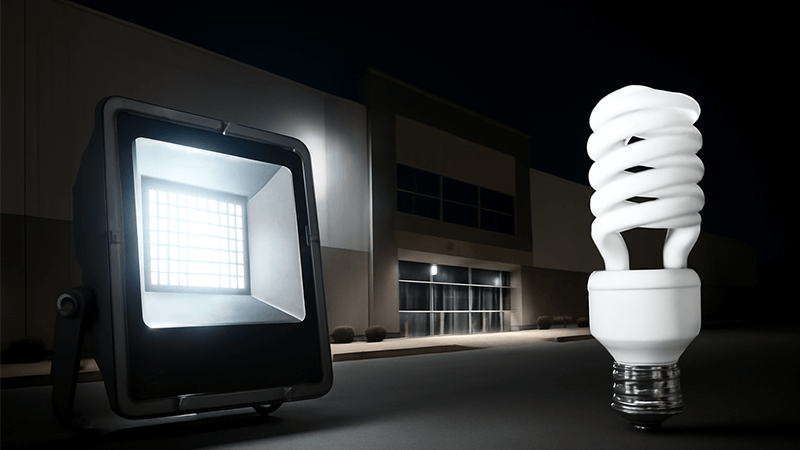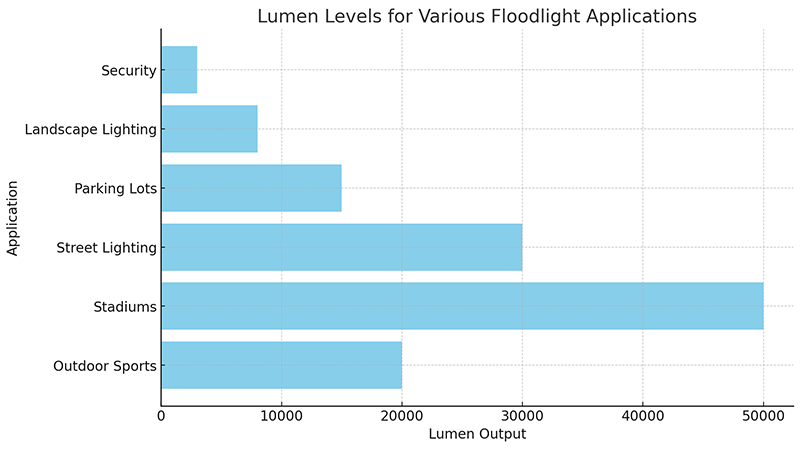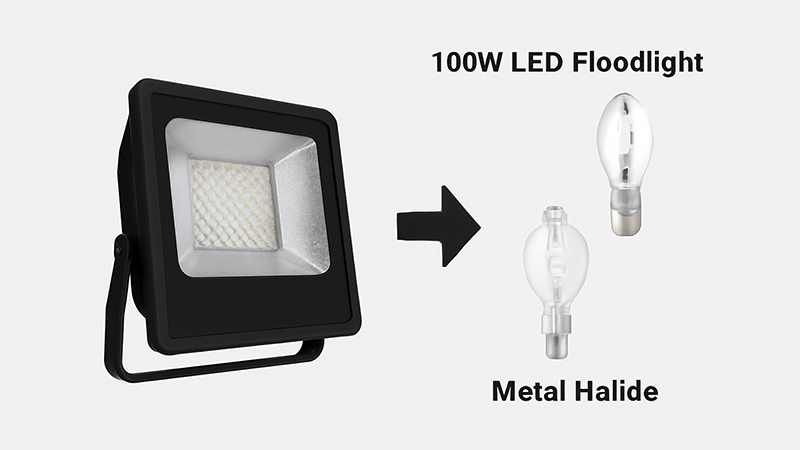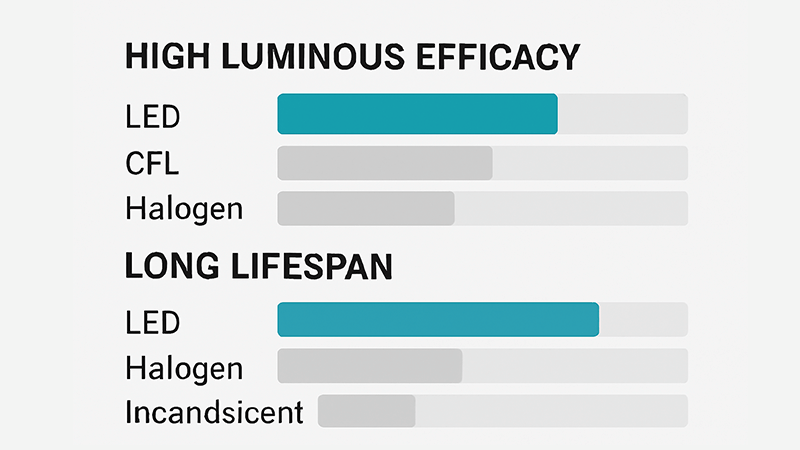Confused by floodlight choices? Picking the wrong one wastes money and compromises safety. You need to understand their true purpose to make the right decision for your project.
Comparing them is like comparing apples and oranges. High-lumen LED floodlights provide powerful, targeted brightness for large outdoor areas. Traditional energy-saving bulbs are for low-intensity, general indoor lighting. The best option depends entirely on the job you need the light to do.

I’ve been in the lighting industry since I started my career in a factory. Now, running my own manufacturing business, I see the same costly mistake over and over: people choose lights based on the wrong criteria. They ask if a light is "energy-saving" when they should be asking if it’s "right for the task." The biggest waste of energy isn’t using a high-wattage bulb; it’s using the wrong light for the job. This isn’t just about comparing two types of lights. It’s about understanding that one is a specialized tool for performance, and the other is for general use. Let’s break this down so you can see why this distinction is so critical for your projects.
How many lumens is a good flood light?
Choosing a floodlight’s brightness can feel like a random guess. But guessing wrong means you either have dangerous dark spots or you’re just burning money on wasted electricity.
A good floodlight for a small home driveway might be 700-1,300 lumens. For commercial building exteriors, you’ll need 5,000-20,000 lumens. Large areas like shipping ports or stadiums require 50,000 to over 100,000 lumens. “Good” means it safely and effectively lights your specific space.

The question isn’t just about how many lumens are "good," but what you need those lumens to do. As a purchasing manager, your goal is to find a solution, not just a product. The right lumen output depends entirely on the application. A light that’s perfect for a backyard will be dangerously inadequate for a commercial loading dock.
I worked with a client once who tried to save money by under-lighting his warehouse’s parking lot. He bought several low-lumen floodlights, thinking more fixtures meant better coverage. He was wrong. The result was a patchwork of dim areas and shadows, which unfortunately led to a vehicle break-in. We came in and did a proper lighting simulation. We found that just a few high-lumen LED floodlights, positioned correctly, could provide bright, even illumination across the entire area. The key was a professional plan, not just a cheap purchase. This is where understanding the application becomes so important.
Lighting Needs by Application
Here’s a simple table to help guide your decisions:
| Application |
Recommended Lumen Range |
Key Considerations |
| Residential Driveways & Patios |
700 – 1,500 lumens |
Focused beam, motion sensor integration, warm color temperature. |
| Commercial Facades & Parking Lots |
5,000 – 20,000 lumens |
Wide beam angle for even coverage, durability, high Color Rendering Index (CRI). |
| Industrial Yards & Construction Sites |
20,000 – 50,000 lumens |
High luminous efficacy, robust IP rating (IP65+), vibration resistance. |
| Sports Stadiums & Large Ports |
50,000 – 150,000+ lumens |
Precision optics, low glare (UGR), long lifespan for minimal maintenance. |
You have to think beyond the number. A 10,000-lumen floodlight with a narrow 30-degree beam is a spotlight. The same 10,000 lumens spread over a 120-degree beam provides broad, even coverage. Choosing the right lumens is the first step in designing a safe, effective, and efficient lighting system.
What is a 100W LED flood light equivalent to?
You see "100W LED" and try to compare it to old bulbs. This is confusing because old wattage numbers are misleading and lead to buying the wrong light for the job.
A 100W LED floodlight’s brightness varies based on its efficiency. It can produce from 10,000 to over 15,000 lumens, typically replacing a 400W metal halide or 1000W halogen bulb. You must check lumens and luminous efficacy (lm/W), not just watts, for a true comparison.

When I first started manufacturing LED lights, the biggest challenge was re-educating my clients. They would always ask, "How many watts is this light?" I had to teach them to ask better questions: "How many lumens does it produce?" and "What is its luminous efficacy?" This shift in thinking is the key to understanding modern lighting. We’ve moved from measuring energy consumption (Watts) to measuring light output (Lumens).
The Old Way: Measuring Power with Watts
In the past, with technologies like incandescent and halogen, more watts always meant more light. A 100W bulb was brighter than a 60W bulb. This was simple, but it was a measure of electricity use, not brightness. It encouraged a culture of inefficiency.
The New Standard: Measuring Brightness with Lumens
LEDs changed everything. They are incredibly efficient at converting watts into light. A 100W LED can be twice as bright as another 100W LED from just a few years ago. That’s why watts are now a nearly useless metric for comparing brightness. The only number that matters for brightness is lumens. The critical metric for efficiency is luminous efficacy, measured in lumens per watt (lm/W). A higher lm/W value means the light produces more brightness for less energy. For a purchasing manager like Shaz, this number is a direct indicator of long-term operational savings.
Real-World Equivalency Comparison
This isn’t about a simple one-to-one replacement. It is about a massive upgrade in performance and efficiency.
| Light Technology |
Power to Match a 12,000 Lumen LED |
Lifespan |
Key Disadvantage |
| LED |
100W |
50,000+ hours |
Higher initial cost |
| Metal Halide (MH) |
400W |
15,000 hours |
Long warm-up time, color shifting |
| High-Pressure Sodium (HPS) |
250W |
24,000 hours |
Very poor color quality (yellow/orange) |
| Halogen |
1000W |
2,000 hours |
Extremely high energy use, produces intense heat |
As you can see, a 100W LED doesn’t just replace a 400W metal halide; it outperforms it in every way while using 75% less energy. Asking what it’s "equivalent to" is the beginning of the conversation. The real story is the huge leap in efficiency and performance.
How many lumens is an energy saving bulb?
Do you see an "energy-saving" bulb and think it can light a large area? This mistake leads to dim, useless, and even unsafe environments because the tool is wrong for the task.
A standard energy-saving bulb, like a Compact Fluorescent (CFL), typically produces 400 to 1,600 lumens. This is enough for a desk lamp or a small room. It is completely unsuitable for floodlighting applications, which demand much higher brightness and durability.

This gets to the heart of the matter. Comparing a high-lumen floodlight to an "energy-saving" CFL isn’t a fair fight. They are different species, designed for completely different habitats. A CFL is built for low-demand, indoor, general-purpose lighting. An LED floodlight is a high-performance machine built for powerful outdoor illumination. The biggest waste of money and energy is a fundamental application mismatch.
I remember a contractor who tried to light a small auto repair shop using a dozen high-wattage CFLs. On paper, he thought he was saving money. In reality, it was a disaster. The lights took minutes to warm up to full brightness, they flickered in the cold garage, and the constant on/off cycles burned them out in months. The light quality was terrible, making it hard to see details. We replaced his entire setup with just four 50W LED high bay lights. The space was instantly bright, the light was clean and clear, and his energy bill went down. More importantly, his mechanics could work safely and efficiently.
Defining "Energy-Saving Bulb"
The term usually refers to Compact Fluorescent Lamps (CFLs), which were the first mainstream replacement for inefficient incandescent bulbs. While they save energy compared to incandescents, they are now an outdated technology compared to LEDs.
Application Mismatch: The Biggest Waste
Here is where these two products live. Trying to make one do the other’s job is a recipe for failure.
| Feature |
Energy-Saving Bulb (CFL) |
High-Lumen LED Floodlight |
| Primary Use |
Indoor, general room lighting |
Outdoor, large area/security lighting |
| Typical Lumens |
400 – 1,600 |
5,000 – 100,000+ |
| Durability |
Fragile glass tube, sensitive to cold |
Robust solid-state construction, weatherproof |
| Performance |
Slow warm-up, lifespan reduced by on/off |
Instant-on, unaffected by switching |
| Environmental |
Contains mercury |
Mercury-free |
Using a CFL where you need a floodlight is like bringing a scooter to a trucking job. It will fail, and the cost of that failure—in safety, productivity, and replacement—is far greater than the few dollars saved on the initial purchase.
What is the most energy-efficient type of lighting?
When you look for efficient lighting, it’s easy to get lost. Choosing an option that is only "kind of efficient" will cost you much more in energy and maintenance over time.
LEDs (Light Emitting Diodes) are, by a very large margin, the most energy-efficient lighting technology available today. With superior luminous efficacy, extremely long lifespans, and unmatched durability, they outperform all older technologies like fluorescent, halogen, and metal halide.

This is where the entire discussion comes together. The question isn’t whether to pick a bright light or an energy-saving light. Modern technology gives you both. High-lumen LED floodlights are the "energy-saving" choice for high-output applications. This represents the end of an old era and the beginning of a new one. We are no longer forced to choose between performance and efficiency.
Beyond Watts: A Holistic View of Efficiency
True efficiency isn’t just about low wattage. It’s about the Total Cost of Ownership (TCO). For a purchasing manager like Shaz, this is the most important calculation. TCO includes the initial purchase price, the cost of energy consumed over the light’s life, and the cost of replacement bulbs and labor for maintenance. While LEDs may have a higher upfront cost, their TCO is drastically lower.
A high-lumen LED floodlight is not an expense; it is a high-return investment. The savings on energy and maintenance pay back the initial cost, often within just one or two years.
Let’s compare the 5-year TCO for lighting a small commercial lot requiring 40,000 lumens:
| Cost Factor |
2x 20,000 Lumen LED Floodlights (400W total) |
4x 400W Metal Halide (1,600W total) |
| Initial Hardware Cost |
$400 |
$300 |
| Energy Cost (5 years) |
$1,314 |
$5,256 |
| Replacement Bulbs & Labor |
$0 |
$600 (2 replacement cycles) |
| Total Cost of Ownership |
$1,714 |
$6,156 |
The choice is clear. The LED solution saves over $4,400 over five years for just one small application. This is the power of a superior technology. Choosing LED is also an environmental vote. They contain no toxic mercury and their lower energy consumption means a smaller carbon footprint. This isn’t just a better product; it’s a smarter, more responsible choice for the future.
Conclusion
Stop comparing high-lumen floodlights to general-purpose energy-savers. Instead, choose the right tool for the job. Modern LEDs provide both powerful brightness and superior efficiency, making them the best investment.